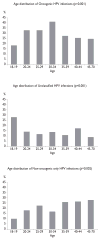Human papillomavirus infection in men residing in Brazil, Mexico, and the USA
- PMID: 18852938
- PMCID: PMC3495064
- DOI: 10.1590/s0036-36342008000500014
Human papillomavirus infection in men residing in Brazil, Mexico, and the USA
Abstract
Objective: To assess Human Papillomavirus (HPV) type distribution among men ages 18 years and older recruited from three different countries utilizing a common protocol for sampling HPV detection, and to evaluate whether HPV detection differs by age and country. MATERIAL AD METHODS: The study protocol includes a pre-enrollment run-in visit, a baseline (enrollment) visit, and nine additional visits after enrollment scheduled six months apart. For this analysis, the first 1160 men who completed both the run-in and baseline visit were included. To maximize sampling and prevent fraying of applicators, three different applicators were utilized to sample the external genitalia of participants among different anatomic sites. These samples were later combined to form a single sample for the detection of HPV using polymerase chain reaction (PCR) for amplification of a fragment of the HPV L1 gene.
Results: Among 1160 men from Brazil, Mexico, and the United States (U.S.), overall HPV prevalence was 65.2%; with 12.0% oncogenic types only, 20.7% non-oncogenic types only, 17.8% both oncogenic and non-oncogenic, and 14.7% unclassified infections. Multiple HPV types were detected in 25.7% of study participants. HPV prevalence was higher in Brazil (72.3%) than in the U.S. (61.3%) and Mexico (61.9%). HPV 16 (6.5%), 51 (6.5%), and 59 (5.3%) were the most commonly detected oncogenic infections, and HPV 84 (7.7%), 62 (7.3%), and 6 (6.6%) were the most commonly detected non-oncogenic infections. Overall HPV prevalence was not associated with age. However, significant associations with age were observed when specific categories of oncogenic, non-oncogenic, and unclassified HPV infections were considered.
Conclusions: Studies of HPV type distribution among a broad age range of men from multiple countries is needed to fill the information gap internationally with respect to our knowledge of HPV infection in men.
Conflict of interest statement
Figures

Similar articles
-
The human papillomavirus infection in men study: human papillomavirus prevalence and type distribution among men residing in Brazil, Mexico, and the United States.Cancer Epidemiol Biomarkers Prev. 2008 Aug;17(8):2036-43. doi: 10.1158/1055-9965.EPI-08-0151. Cancer Epidemiol Biomarkers Prev. 2008. PMID: 18708396 Free PMC article.
-
Circumcision and sexual behavior: factors independently associated with human papillomavirus detection among men in the HIM study.Int J Cancer. 2009 Mar 15;124(6):1251-7. doi: 10.1002/ijc.24097. Int J Cancer. 2009. PMID: 19089913 Free PMC article.
-
Race and prevalence of human papillomavirus infection among men residing in Brazil, Mexico and the United States.Int J Cancer. 2012 Aug 1;131(3):E282-91. doi: 10.1002/ijc.27397. Epub 2012 Jan 11. Int J Cancer. 2012. PMID: 22161806 Free PMC article.
-
The prevalence of genital HPV and factors associated with oncogenic HPV among men having sex with men and men having sex with women and men: the HIM study.Sex Transm Dis. 2011 Oct;38(10):932-40. doi: 10.1097/OLQ.0b013e31822154f9. Sex Transm Dis. 2011. PMID: 21934568 Free PMC article.
-
The optimal anatomic sites for sampling heterosexual men for human papillomavirus (HPV) detection: the HPV detection in men study.J Infect Dis. 2007 Oct 15;196(8):1146-52. doi: 10.1086/521629. Epub 2007 Sep 17. J Infect Dis. 2007. PMID: 17955432 Free PMC article.
Cited by
-
Test-retest reliability of a sexual behavior interview for men residing in Brazil, Mexico, and the United States: the HPV in Men (HIM) Study.Am J Epidemiol. 2009 Oct 15;170(8):965-74. doi: 10.1093/aje/kwp225. Epub 2009 Sep 9. Am J Epidemiol. 2009. PMID: 19741044 Free PMC article.
-
Prevalence and incidence of anal human papillomavirus infection in Mexican men: Need for universal prevention policies.Salud Publica Mex. 2018 Nov-Dec;60(6):645-652. doi: 10.21149/8454. Salud Publica Mex. 2018. PMID: 30699269 Free PMC article.
-
High prevalence of co-infection between human papillomavirus (HPV) 51 and 52 in Mexican population.BMC Cancer. 2017 Aug 8;17(1):531. doi: 10.1186/s12885-017-3519-7. BMC Cancer. 2017. PMID: 28789619 Free PMC article.
-
Prevalence of and risk factors for anal human papillomavirus infection in men who have sex with women: a cross-national study.J Infect Dis. 2010 May 15;201(10):1498-508. doi: 10.1086/652187. J Infect Dis. 2010. PMID: 20367457 Free PMC article.
-
Prevalence of DNA-HPV in male sexual partners of HPV-infected women and concordance of viral types in infected couples.PLoS One. 2012;7(7):e40988. doi: 10.1371/journal.pone.0040988. Epub 2012 Jul 17. PLoS One. 2012. PMID: 22815888 Free PMC article.
References
-
- Agarwal SS, Sehgal A, Sardana S, Kumar A, Luthra UK. Role of male behavior in cervical carcinogenesis among women with one lifetime sexual partner. Cancer. 1993;72:1666–1669. - PubMed
-
- Buckley JD, Harris RW, Doll R, Vessey MP, Williams PT. Case-control study of the husbands of women with dysplasia or carcinoma of the cervix uteri. Lancet. 1981;2:1010–1015. - PubMed
-
- Thomas DB, Ray RM, Pardthaisong T, Chutivangse S, Koetsawang S, Silpisornkosol S, et al. Prostitution, condom use, and invasive squamous cell cervical cancer in Thailand. Am J Epidemiol. 1996;143:779–786. - PubMed
-
- Zunzunegui MV, King MC, Coria CF, Charlet J. Male influences on cervical cancer risk. Am J Epidemiol. 1986;123:302–307. - PubMed
-
- Bosch FX, Castellsague X, Munoz N, De SDanjosé S, Ghaffari AM, González LC, Meijer CU, Shah KV, De Sanjosé S, et al. Male sexual behavior and human papillomavirus DNA: key risk factors for cervical cancer in Spain. J Natl Cancer Inst. 1996;88:1060–1067. - PubMed
Publication types
MeSH terms
Grants and funding
LinkOut - more resources
Full Text Sources
Medical
Miscellaneous
